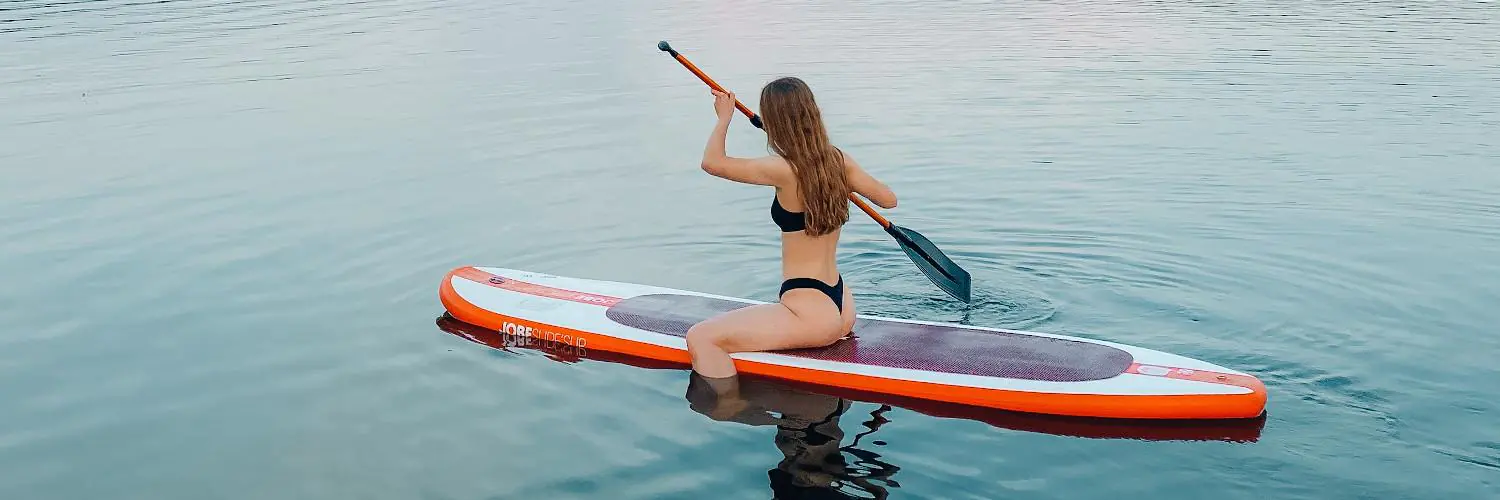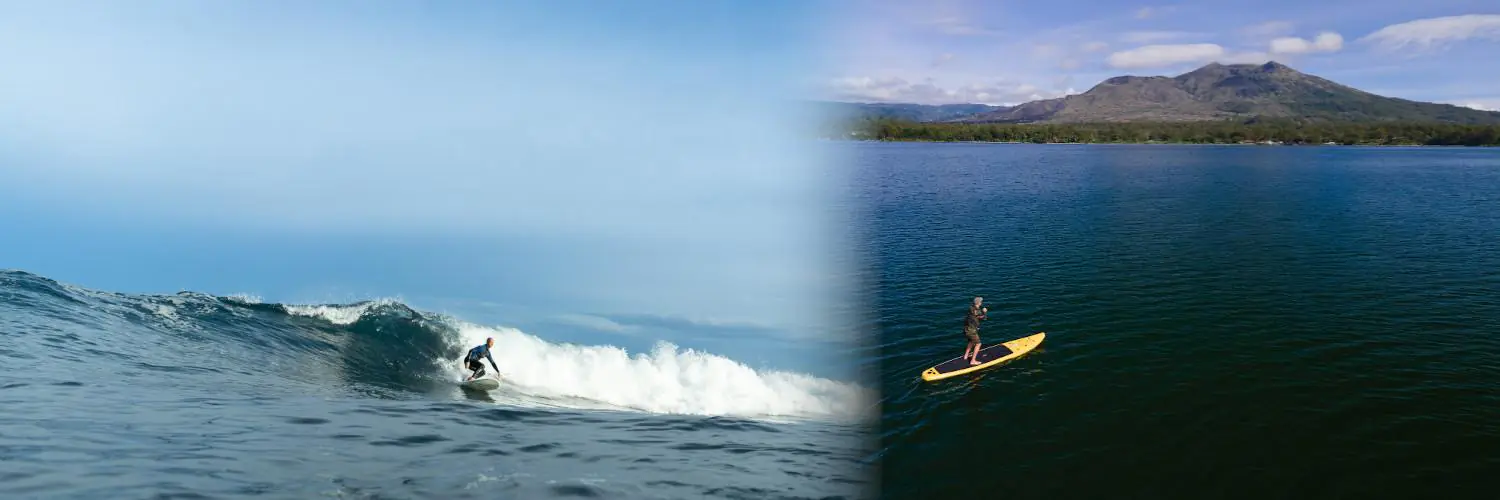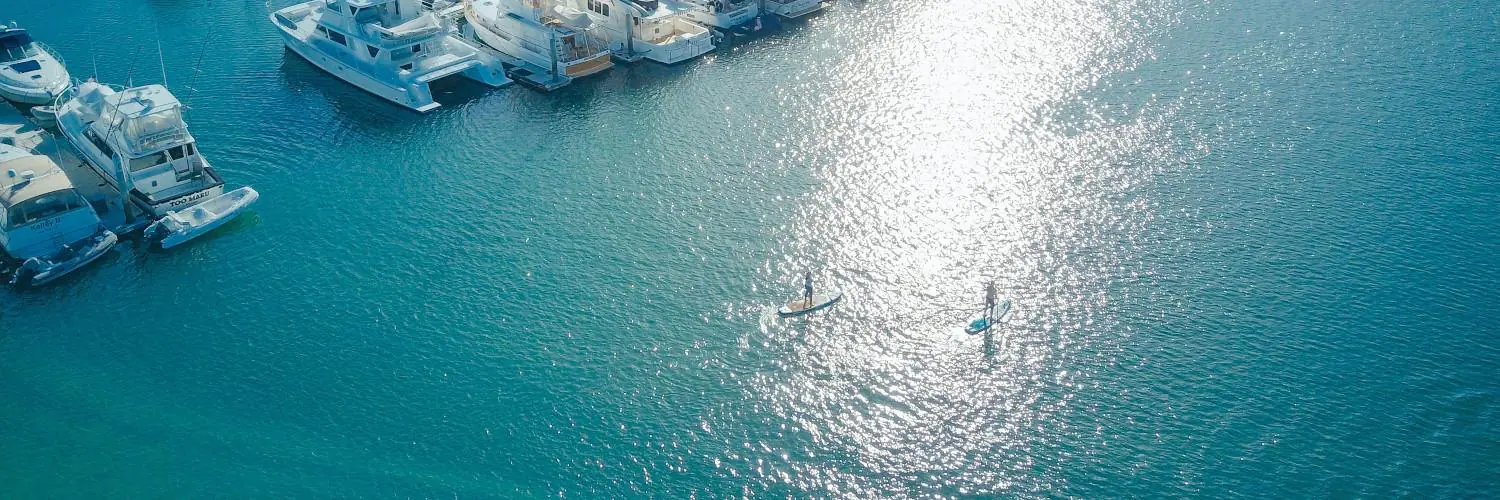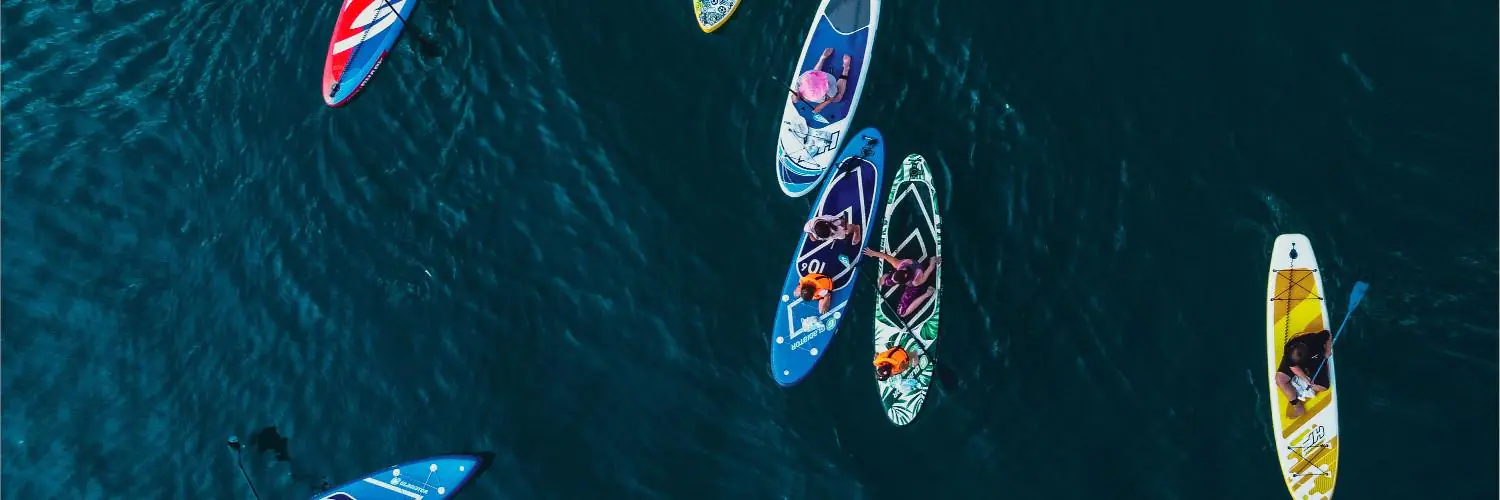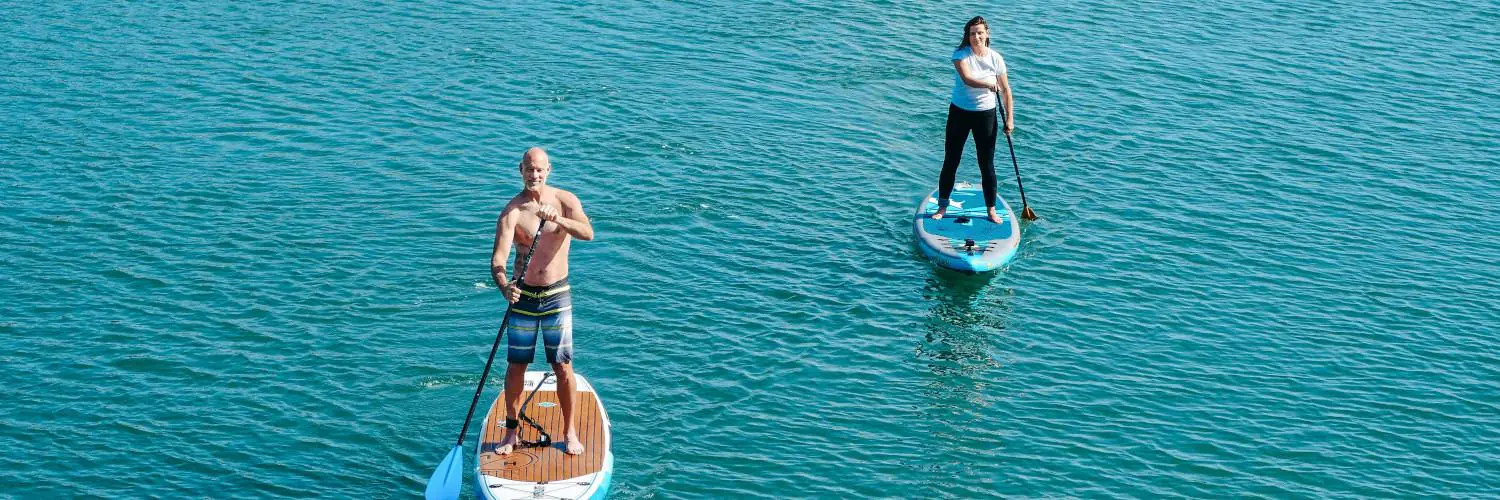Paddleboarding is now really liked and is done for fun and contests. Many people want to know how the boards are made. Let’s talk about what they’re made of and how.
At the core of most solid paddle boards lies either hollow wood or foam, with layers of fiberglass and epoxy resin lending additional strength and durability. These make the foundation for most of the paddle boards available. However, it is worth noting that more cost-effective options may be constructed solely from foam, while high-end boards often utilize carbon fiber over foam cores for an even lighter and more resilient product.
In contrast to their solid counterparts, inflatable paddle boards are designed with portability in mind, relying on PVC plastic outer layers and an inflatable core for buoyancy. These boards are made for many people and water conditions.
Table of Contents
Stand Up Paddle Board Materials
Fiberglass
Fiberglass is a common material used in stand up paddle board construction. Most solid paddle boards are made of fiberglass and epoxy resin layers over hollow wood or foam cores. This a strong but light foundation for the board. Fiberglass fabric strips are applied onto the board’s core in a process called lamination. The epoxy resin is then added to create a robust and durable surface. Board stability, weight, and durability are influenced by the number of fiberglass layers used.
Carbon Fiber
Carbon fiber is a high-performing, premium material mostly used in high-end boards. Like fiberglass, carbon fiber is applied over a foam core, typically expanded polystyrene foam (EPS). The main advantage of carbon fiber is its strength-to-weight ratio, allowing for an exceptionally lightweight and highly responsive paddle board.
Plastic
Thermoplastic, polyethylene, and rotomolded polyethylene and other plastics can be used to make boards. They are strong and not expensive, which is good for people just starting out. Rotomolded polyethylene involves a process in which molten plastic is poured into a mold and rotated to evenly distribute the material. Plastic paddle boards are often heavier than their fiberglass and carbon fiber counterparts but are more resistant to damage from impacts and abrasions.
Foam
Foam paddle boards, often made from EPS foam, provide a lightweight and budget-friendly option. A cushioned surface, suited for beginners and recreational paddling, is made when the foam core is covered with a soft top material. While this material is not as rigid or durable as fiberglass or carbon fiber, it offers an affordable entry point into the sport of stand up paddling.
Wood
A wood solid core is usually made with pine and paulownia. Additional strength and durability is added with layers of fiberglass and epoxy resin, which also keeps the natural beauty and aesthetic of the wood grain. Wood paddle boards look and feel great, but they are usually heavier.
Inflatable
Inflatable paddle boards are constructed from a heavy-duty PVC outer layer, which is designed to be durable and puncture-resistant. An inflatable core, typically made of drop-stitch fabric, allows the paddle board to be inflated to a high pressure, creating a stable surface for paddling. Because inflatable paddle boards can be deflated and rolled up, they are perfect for those with limited storage space or want it easy to transport.
Types of Stand Up Paddle Boards
Paddle boarding is a fun water activity. There are different SUP needs and also different board types. Let’s look at the kinds of paddle boards you can get, like rigid boards, inflatable boards, soft top boards, yoga boards, plastic boards, wooden boards, and foam boards.
Rigid Boards
Rigid boards, also known as hard boards, are typically made from an EPS foam core and encased in layers of fiberglass, epoxy, or carbon fiber, which adds to their strength and durability. These boards provide really good performance and stability and so are ideal for intermediate to advanced paddlers. Touring, racing, and wave riding are suited for rigid boards.
Inflatable Boards
Inflatable stand up paddle boards are made from durable PVC material and can be easily inflated and deflated for convenient storage and transportation. They have good stability and take less damage, making them good for new paddlers. Travel, camping, and leisure are well served by inflatable paddle boards.
Soft Top Boards
Soft surface boards have a squishy foam top and sides, which make them strong and good for people just starting out or who paddle casually. They are good for beginners because they are more forgiving than rigid boards.
Yoga SUPs
Yoga stand up paddle boards are specifically designed for SUP yoga enthusiasts, featuring a larger surface area and a more stable platform for practicing various yoga poses. These are available as rigid and inflatable boards.
Plastic Paddle Boards
Plastic paddle boards are made from durable polyethylene material and offer a rugged, low-maintenance option for stand up paddle boarding. They are good for the budget-minded and beginners because they are more affordable.
Wooden Paddle Boards
Having a unique look, wooden boards can be made from bamboo or cedar. They are great for recreational paddlers because they float really well and also offer style and sophistication.
Foam Paddle Boards
Foam paddle boards are made from soft, yet durable, materials that provide a comfortable and beginner-friendly experience. They have a soft surface that reduces injury from falls and impacts. Compared to rigid boards, they are more affordable.
In short, there are many preferences, skill levels, and budgets, there is also a wide variety of stand up paddle boards available. Whether you’re new to the sport or are an experienced SUP enthusiast, there’s a paddle board out there to meet your needs.
Board Design and Performance
Size and Weight Capacity
When it comes to SUP board design, size and weight capacity play a crucial role in determining its performance. Stand up paddle boards come in various sizes ranging from short and wide boards, suitable for beginners, to longer and narrower boards designed for experienced paddlers. Weight capacity is determined by the volume and buoyancy of the board. Typically, larger boards with greater volume can support more weight, while smaller boards tend to have a lower weight capacity.
Stability and Buoyancy
Staying steady matters a lot for how well a SUP board works, especially for newbies. Wider boards give better balance and steadiness, while narrower ones need more balance and work best for skilled paddlers. How floaty the board is, which depends on how much space it takes up, is closely linked to its steadiness. Boards with more space are floatier and give better support, keeping the paddler more steady.
Maneuverability and Speed
Maneuverability and speed depend on several factors, including the shape, length, width, and fin setup of the SUP. Smaller boards turn fast. Bigger boards are quicker but better for long paddling. Fins help the board with direction.
Durability and Lifespan
The durability of a stand up paddle board primarily depends on the materials used in its construction. Most solid paddle boards are made of materials like fiberglass or carbon fiber layered over hollow wood or foam cores. Meanwhile, inflatable paddle boards are constructed from PVC plastic outer layers over an inflatable core. Each has its own characteristics, like carbon fiber is light and strong and inflatables are more portable and adaptable. The lifespan of a paddle board depends on its material, construction quality, and how well it is cared for, with a well-maintained board potentially lasting many years.
Accessories and Additional Features
Pumps and Inflation
A high-quality pump is best for inflatable stand-up paddle boards. Electric pumps, such as the OutdoorMaster Shark II Pump, make inflating your SUP quick and easy, saving you time and effort before hitting the water. Some pumps have pressure gauges to make sure you inflate them right.
Repair Kits
Inflatable stand-up paddle boards can sometimes get punctured or damaged, making repair kits a necessary accessory. These kits typically include:
- Patches for punctures
- Adhesive for sealing
- A valve tightening tool
Keeping a repair kit handy can save a day on the water, ensuring your board stays in top condition.
Backpacks and Travel Bags
Transporting and protecting your stand-up paddle board is made easier with a dedicated backpack or travel bag. These bags usually offer:
- Padded shoulder straps for comfort
- Compression straps for secure storage
- Water-resistant materials to protect against the elements
Popular brands, such as Starboard SUP and BOTE, offer high-quality options for storing and carrying your paddle board.
Anchors
To keep your stand-up paddleboard from drifting, use an anchor. You can use one while doing yoga, fishing, or taking pictures to keep yourself in place. There’s are different types of anchors available, including:
- Folding anchors
- Suction cup anchors
- Sandbag anchors
Choose an anchor that best suits your specific needs and conditions.
Popular Brands
When it comes to stand-up paddle boards and accessories, some popular brands stand out for their quality and performance. A few notable examples include:
- Starboard SUP: Known for innovative designs and eco-conscious materials
- BOTE: Offers a range of SUPs, including the Breeze Aero, designed for versatility and stability
- Other reputable manufacturers: Worth considering for durable, reliable products and accessories
Investing in well-known brands can ensure a better experience on the water with your stand-up paddle board.
Cost and Value Considerations.
When considering the purchase of a stand up paddle board (SUP), it is important to take into account the cost and value of the different materials and designs available on the market. Now, we’ll discuss how the materials and design change paddleboard cost and value, and how they’re like or unlike kayaks.
One of the primary materials used in making SUPs is fiberglass. Fiberglass SUPs can offer a good balance between cost and performance, being relatively lightweight and easy to maneuver. These SUPs typically range in cost from $700 to over $1,500, depending on the quality and features of the board.
PVC and Hypalon are used to make the popular inflatable paddle boards. Inflatable SUPs offer their own advantages, such as ease of transport and storage, and they are available in a wide range of costs from about $700 to more than $1,500+ for more advanced designs.
You should evaluate the value an SUP offers when considering its cost.Those seeking a high-performance board with more advanced features, such as carbon fiber construction, should expect to pay a premium. Experienced paddlers will like these better as they have better maneuverability and glide performance.
In addition to material choices, some paddle boards are designed with features that enable you to adapt their functionality. For example, the Isle Switch offers a hybrid SUP design that allows you to switch between a kayak (with a seat and dual-headed paddle) and a standard SUP. They add more choices for a bit more money.
Comparing the cost and value of SUPs with kayaks can vary greatly according to the materials, designs, and features of each. Kayaks are, however, generally more stable and easier to use for beginners, whereas SUPs usually require more balance and skill. In terms of pricing, both kayaks and SUPs can range from affordable entry-level options to high-performance, costly models.
When thinking about the price and worth of stand up paddles, buyers should think about what they need, how good they are, and what they expect. Buyers should think about their needs, skill, and expectations when deciding about the cost and value of stand up paddle boards.

